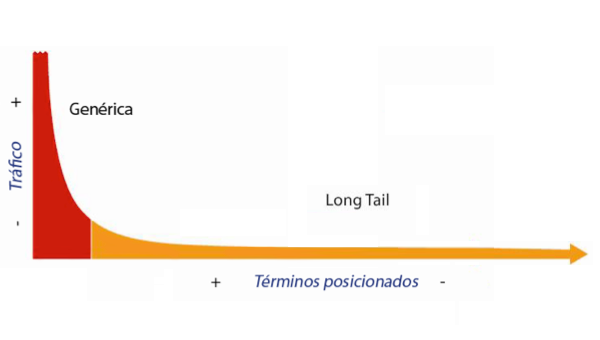Written by Fani Sánchez
Long tail keywords are generally terms with low traffic potential but low competition and therefore easier to rank for.
From the analysis of the traffic of any website, it is clear that the Pareto principle is fulfilled: approximately 20% of the traffic comes from generic searches. We call this part of the curve the “head”. While the remaining 80% of visits come to the portal through much more specific searches, which only one or a few people repeated. This is called the long tail of the curve, i.e. the long tail. In the following image we can see the typical shape of the long tail curve, with a narrow head section – red part of the curve – where the high number of visits received from a relatively small number of different search phrases is presented. Instead, the tail of the curve – the orange part – is extended asymptotically to represent the wide variety of different specific searches that led to a visit to the portal.
Purpose of keyword categorization
Keyword categorization serves a dual function:
- Determining your site’s generic keyword ceiling is an unequivocal starting point for effective keyword consulting, where resources are not wasted.
- By grouping words with similar characteristics or that share levels of architecture on the web (for example: long tail keywords could be blog tags, semi-generic keywords would be services…) we can monitor large-scale changes the positioning rankings and determine if there are problems in a specific group of words.
Search intent in long tail keywords
Throughout the purchase decision process, a user may return to the same website in several successive browsing sessions in which the type of searches will evolve from the most generic to the most specific concept. Let’s see how:
- A user who intends to buy a new computer model is very likely to start his purchase decision process with a first phase in which he will try to research and gather information on the available types, features, prices, brands, etc. So most commonly you start your Internet searches with generic keywords such as “laptops”, “notebook”, “notebook”, etc. A large percentage of these visits arrive at the home page or one of the product family pages. Although generic searches can generate a lot of traffic, it will be of poorer quality, since we know less about the search intent and the need that triggered the Internet search. Therefore, we can expect a worse conversion rate from this type of traffic.
- Once a certain amount of information has been collected, the user will likely will opt for one type of device. Perhaps what determines your decision is a particular brand, although it may also be a particular type of computer (tablet, laptop…) or a particular feature (15-inch screen, under 400€…). Such searches, which already include some characteristic of the searching computer, are classified as semi-generic, since they respond to some kind of content grouping criteria. It is likely that the user would then land on a more specific page, such as the product family or product page.
- In this final phase, the user has already identified the device he/she wants to purchase. They may have gone to a physical store to see it, touch it and compare prices (showrooming). will make a final search in which you will enter exactly the model and reference of the model you want and will open several browsers with the corresponding product sheet in different portals. The one that offers you the computer at the lowest price and inspires sufficient confidence will be the one most likely to convert. These would be the visits that would come from long-tail searches: very specific queries that usually generate a higher conversion rate.
